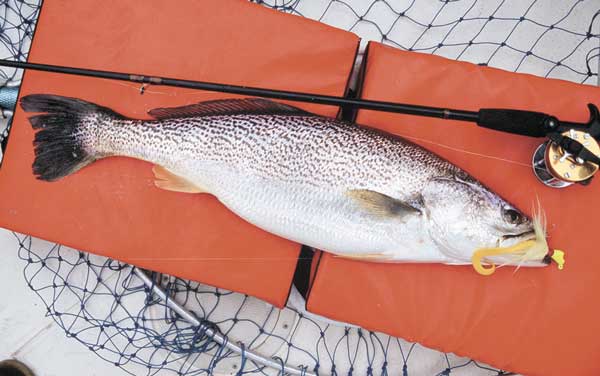
Weakfish are a second saltwater trout, in addition to specks, that are found at inshore waters this month.
Weakfish don’t get any respect.
Tar Heels get more excited about spotted sea trout, probably because anglers catch lots of them from the grass beds of Pamlico Sound during the warm season and get runs of big specks at Cape Point each winter.
North Carolina once had a pretty good winter fishery for weakfish, but that’s been a problem as stocks declined, improved slightly but only briefly, then declined again no matter what management measures were implemented.
The commercial fishery has almost collapsed. Sport fishing isn’t what it was and differs from place to place with guides at the Chesapeake Bay-Virginia Beach area fishing differently from guides near Oregon Inlet, Cape Hatteras, Ocracoke Inlet, Beaufort Inlet and Cape Lookout.
In Tar Heel waters, anglers mostly fish bottoms where gray trout are mixed with puppy drum, flounder and spotted sea trout. If structure is available, anglers also might land black drum.
In Virginia waters, gray trout are fished mostly at rocky bottoms where they mix with black drum, tautog (blackfish), black sea bass and flounder.
From central North Carolina, these areas are about the same driving time.
Oregon Inlet to Ocracoke Inlet
Guide Gary Dubiel of Oriental said there are two inside seasons for gray trout — April and early May, then October into early November, after which they leave for the ocean well off the beaches.
He finds grays during the spring and fall in less than 6 feet of water mixed with speckled trout or separated just at the edges of the speck groups.
“The best locations are oyster bars, 4- to 6-foot depth breaks, points of islands or where they all come together,” he said.
“Most are young of the year, about 1 to 1 ½ pounds, and a big fish would be 3 or 4 pounds max. But years ago, we got some 6- to 7-pound fish at Oregon Inlet.”
During the summer, gray trout move to deeper and cooler water, about 14 to 18 feet, especially near structure with current, Dubiel said.
“In spring and fall they’re active in Pamlico Sound in cooler to cold water, from 75 degrees to 62 or 63 degrees,” he said.
“The action is good in October, but by late November they leave Pamlico Sound through Ocracoke Inlet.”
Dubiel bases his assumptions about weakfish after tracking the fish for several years.
Ocracoke seems to be their major pathway out of Pamlico Sound.
Dubiel said he thought the grays stayed in the ocean from November or December through February, where the commercial guys at one time had a decent fishery.
Dubiel fishes inside waters with ¼- to 3/8-ounce lead-head jigs with a 3- or 4-inch plastic strip or bucktail tipped with shrimp, fish or Fish Bite liquid scent.
During the summer, he fishes deeper water with a slightly heavier jig if there’s a current or uses cut bait or live bait.
He doesn’t chase gray trout in winter, since the speck fishing inshore is too good that time of year, and he’d rather fish for specks and red drum.
Beaufort Inlet
Noah Lynk is a Harkers Island/Cape Lookout guide who catches gray trout from September to mid October then fishes mostly for inside specks through November.
“September is the best month here for gray trout,” he said.
“They like deep water, usually 10 to 20 feet most places, or even more if you get in the hook at Cape Lookout,” he said, “but the tide must be moving.
“They stop feeding on a slack tide. The best locations are deep channels, the Harkers Island swing bridge, the North River Thoroughfare, Carrot Island channel off Beaufort, the Morehead City Turning Basin, the Atlantic Beach bridge, Cape Lookout Bight, and the offshore reefs AR 315 and AR 330.”
Lynk will use a 1- or 2-ounce jig tipped with fresh shrimp to get down to the bottom, but he also uses Sting Silvers, Gotchas or scented Berkeley Gulp lures.
“Whatever you use, you’ve got to get to the bottom and jig it up and down in the current,” he said. “If the current is strong, go to a 2-ounce jig. If the current is weak, you can scale down to a ½-ounce jig. You can use anything from grubs to shiny lures tipped with fresh shrimp.”
Most people drift for trout, but Lynk stops and anchors wherever he finds a hot spot. Most grays today run 1 to 1 ½ pounds and about 12- to 18-inches long, he said, but he recalled when bigger ones were more common.
Rudee Inlet/ Chesapeake Bay
Rob Wilhoite operates two boats at the Norfolk area and fishes inside and outside waters.
The best time for gray trout there is early spring.
“For a five-week period from late April though May,” he said, “the big spawners are fattening up.”
There are two important areas, with hot spots at each.
“Some of the best action is the Chesapeake Bay Bridge Tunnel (CCBB) route, including the High Level bridge at the eastern end, the WT buoy, the Cell Towers and adjacent artificial reef, and several other well-known bottoms,” he said. “In the ocean there are several Liberty Ships off the eastern shore from the CCBB northward 8 to 10 miles to the Cape Charles area.”
Inside at the CCBB, he drift fishes Sting Silvers, bucktails, or lead-head jigs bounced up and down right off the bottom in 30 to 70 feet of water, because “anything less gets too hot, except at the Cell Towers, where you can fish down to 70 and shallower to 12 feet,” he said.
Wilhoite jigs for small fish, but prefers live bait (a spot or small croaker) or big bucktails for bigger trout early in the morning and later at dusk when the tide is moving.
All good trout areas have rock bottoms, and drifting while bouncing off the bottom loses a lot of rigs to rocks. He always carries a ton of jigs.
“If you’re not losing jigs, you’re not fishing the bottom,” he said.
Winter is striped bass time, so Wilhoite leaves outside winter weakfish to the commercial guys.
Weakfish biology
Weakfish (gray seatrout, gray weakfish), Cynoscion regalis, occur along the coast from Massachusetts Bay to northern Florida, with occasional fish reaching the Gulf coast.
Most populations are associated with local estuaries. Limited mixing of adjacent populations occurs but there’s minimal mixing among distant populations. The closer gray trout are (as with Chesapeake Bay and Pamlico Sound), the more common the mixing but mixing is never pronounced.
They migrate short distances to the north in spring and south in fall, and offshore in the winter.
Weakfish have been reported to attain 3 feet in length and 12 pounds. In shape and in their canine-dominated forward dentition, weakfish resemble spotted seatrout (Cynoscion nebulosis) but range farther northward and prefer colder water.
Gray trout like to eat shrimp and anchovies during the first year of life then prefer shrimp, anchovy and larger fish at ages 1 and 2 and mostly herrings and shads afterward. Their foods also include scup (porgy), worms, crabs, clams, silversides, killifish, and anything else that moves in front of them.
They spawn in estuaries and the near ocean in spring. The juveniles spend the first year of lives inside bays and estuaries, while older fish spend the winter in the ocean.
Gray trout reach sexual maturity after their first to third year (but northern populations mature later). Fish 10 to 12 inches might be 2 years old, and a 30-inch fish may be 12 years old.
Abundances
Weakfish have been in decline along the Atlantic seaboard and prompted the National Oceanic and Atmospheric Administration’s National Marine Fisheries Service to recommend a closure of the fishery in the federal zone for 2007-08.
Fisheries inside the 3-mile limit are regulated by the individual states, but as a team, under the cooperative management recommendations of the Atlantic States Marine Fisheries Commission. The ASMFC usually backs up the feds by complementing their regulations with state regulations, so there is no hole in protection.
In the case of weakfish management, state biologists don’t think the proposed federal guidelines will solve the problem, and have recommended ASMFC wait for further analysis of the problem.
Betty Mitchell Gray, reporting in the Virginia Pilot last June, said the ASMFC’s North Carolina chairman, Bruce Freeman, was reluctant to back the NOAA-NMFS proposal for a closure in state waters to complement the federal closure in the Exclusive Economic Zone.
Freeman, responding to staff biologist concerns, didn’t think overfishing was the cause of the decline and closure wouldn’t be a solution. He suggested the ASMFC instead explore other options.
The delegation put off its response to the ASMFC query about a coastal waters closure until September, and that date was pushed back again until late October.
Each state delegation assigns a state fisheries biologist to a joint Technical Committee that advises the full ASMFC about options to address problems and pending solutions. Lee Paramore is the N.C. technical committee representative to the ASMFC.
“Tagging and especially genetic analysis indicate distinct stocks along the east coast, with northern stocks migrating the greatest distances and southern stocks moving the least,” Paramore said. “That affects how we need to manage weakfish.”
He said northern stocks were suffering the most decline. That led to the question of why NMFS wants to manage southern stocks as though all stocks were in equal decline, which they are not. In recent years, the ASMFC adopted minimum mesh sizes for commercial gear that seemed to increase landings in the late 1990s, and the spawning stock biomass improved to well above what the N.C. Division of Marine Fisheries considered overfishing.
“But since 1999, the stock declines have gotten worse in the middle-Atlantic (northern) states than in states to the south, and the N.C. winter commercial fishery landings have also gone down,” Paramore said. “North Carolina’s recreational catch is slightly increased, with this state a top (recreational) harvester, with everyone else suffering worse declines.”
So what’s going on?
Usually, a stock decline indicates a reduction in the number of eggs being spawned by all age classes (spawning stock biomass) or a failure of the eggs or fry to “recruit” or develop through the larval stage to the juvenile stage during the first year. The usual responses are a moratorium, increased mesh size or other methods to increase recruitment.
After recruitment, the fish are assumed to be a specific year class on their way to a future of growth and incremental mortality from disease, fishing, predation, commercial and recreational harvest.
Sometimes fish are killed by a severe cold snap. But nobody apparently knows what’s happening with weakfish.
“The data show a good spawning stock biomass and recruitment, with good production of age 0 fish, but there seems to be a bottleneck,” Paramore said, “between age 0 and age 1, and nobody knew what is causing it.”
It could be predation of these young fish, but what (or who) are the predators? It’s not fishermen.
Overfishing, Paramore said, isn’t causing the decline.
“Natural mortality is so much larger than fishing mortality,” he said, “that a 25-percent reduction in fishing mortality is unlikely to have a large effect.
“We already have stringent management, and things are remaining pretty bad.”
Management is a complex science, with weakfish or any other fishery.
“For example, a spawning stock biomass can recover quickly under a moratorium, but having a diverse age structure (which stabilizes stocks) takes longer,” Paramore said.
“In the mid 1990s, the top age of weakfish was age VI (6), the current oldest fish are age XII (12), and historically weakfish attained age XVII (17). In the past 15 years, we’ve doubled the maximum-age class of weakfish from 6 to lots of 12 year olds.”
If predation is the cause, could it be striped bass feeding on young weakfish? Paramore wouldn’t speculate.
Al Ristori, writing in “The Fisherman,” suggested increasing numbers of (managed) spiny dogfish sharks could be the culprits. But nobody knows for sure.
Currently recreational anglers may keep six gray trout per day with a minimum size of 12 inches.

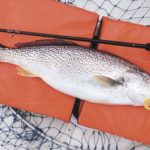
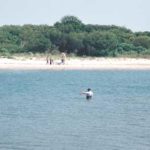
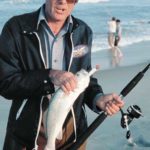
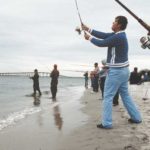
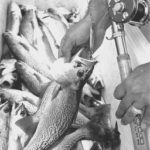


Be the first to comment